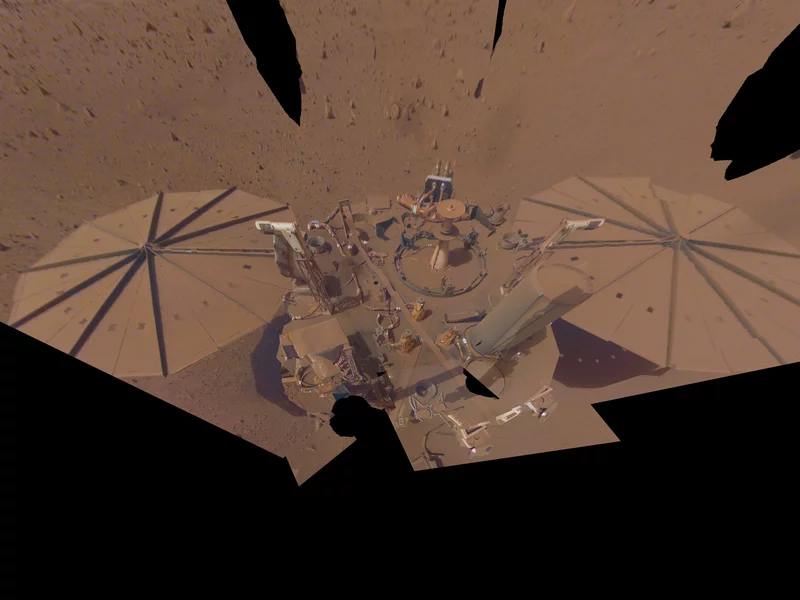On May 5, 2018, NASA shot a revolutionary craft aboard an Atlas V-401 from Vandenberg Air Force Base in California toward the surface of Mars. Its objective was to study the interior of the planet using seismic investigations, geodesy, and heat transport. Now, after more than four years of collecting unique science, the InSight mission (short for Interior Exploration using Seismic Investigations, Geodesy and Heat Transport) has finally come to an end.
Most of what we know about our planet’s deep geology comes from seismic measurements — analyses of how seismic waves pass through our planet’s internal structure. Meanwhile, what we know about Mars largely comes from surface observations. InSight was sent to address that. It offered the first view into the structure of Mars and even found evidence of seismic activity on the Red Planet, hinting at a more complex geology than we thought.
But after four years, InSight may have reached its limit.
Two attempts by mission controllers at the Jet Propulsion Laboratory (JPL) in Southern California to establish contact with the lander resulted in failure, leading engineers to label the spacecraft as a “dead bus” due to its inability to operate.
“We’ve thought of InSight as our friend and colleague on Mars for the past four years, so it’s hard to say goodbye,” said Bruce Banerdt of JPL, the mission’s principal investigator. “But it has earned its richly deserved retirement.”
NASA had previously decided that if the lander failed to respond to two attempts at communication, the mission would be declared complete. While now technically a dead bus, the agency will keep listening for any sign of life from the lander, but at this point, communication with the device is unlikely. Its last communication with mission control was on December 15.
“With InSight, seismology was the focus of a mission beyond Earth for the first time since the Apollo missions, when astronauts brought seismometers to the Moon,” said Philippe Lognonné of Institut de Physique du Globe de Paris, principal investigator of InSight’s seismometer. “We broke new ground, and our science team can be proud of all that we’ve learned along the way.”
Along with daily monitoring by the French space agency Centre National d’Etudes Spatiales (CNES) and the Marsquake Service managed by ETH Zurich, it detected 1,319 Marsquakes, including those caused by meteoroid impacts, the largest of which unearthed boulder-sized chunks of ice at the end of last year.
Data from the seismometer allowed scientists to investigate the planet’s outer, inner and deepest layers, while information from such impacts helps them date the Earth’s surface.
As the years wore on, however, dust built up on the lander’s solar panels, gradually draining InSight’s energy. The seismometer was the last functional instrument remaining when NASA extended the mission earlier this year.
As with any mission to Mars, InSight encountered difficulties. The lander’s self-hammering spike, affectionately dubbed “the mole,” was designed to burrow 16 feet (five meters) into the red planet’s surface, leaving behind a sensor-laden tether that would measure heat within the planet and allow scientists to calculate how much energy was left over from Mars’ formation.
The mole, built for the loose, sandy soil typically encountered on Mars, struggled to dig into the unexpectedly clumpy soil around InSight. The instrument eventually dug a 16-inch (40-centimeter) probe into the Martian surface, gaining crucial information about the planet’s composition and temperature along the way. This info will be helpful for any future missions, whether human or robotic, that involve tunneling below the surface.
The arm and its small scoop were designed to place scientific instruments onto the Martian surface, but creatively, the lander’s engineers were able to get the arm to assist in clearing dust from InSight’s solar panels when the spacecraft’s energy supply began to run low. While it may seem counterproductive, the mission found that by scattering dirt from the scoop onto the panels on windy days, the falling granules would gently sweep dust off the panels.
This was first realized in 2014 when a dust storm gave the Opportunity a new lease on life after the storm cleared debris from the rover’s solar panels, extending its mission. Thereafter, these were officially coined “cleaning events.”
While these extended the other rover missions by years, unfortunately, InSight was located in Elysium Planitia, a space near the equator that did not experience these same types of windstorms. Thus, the program was not able to live out the extended lives that other landers and rovers have had the reputation for.
“InSight has more than lived up to its name. As a scientist who’s spent a career studying Mars, it’s been a thrill to see what the lander has achieved, thanks to an entire team of people across the globe who helped make this mission a success,” said Laurie Leshin, director of JPL, which manages the mission. “Yes, it’s sad to say goodbye, but InSight’s legacy will live on, informing and inspiring.”










